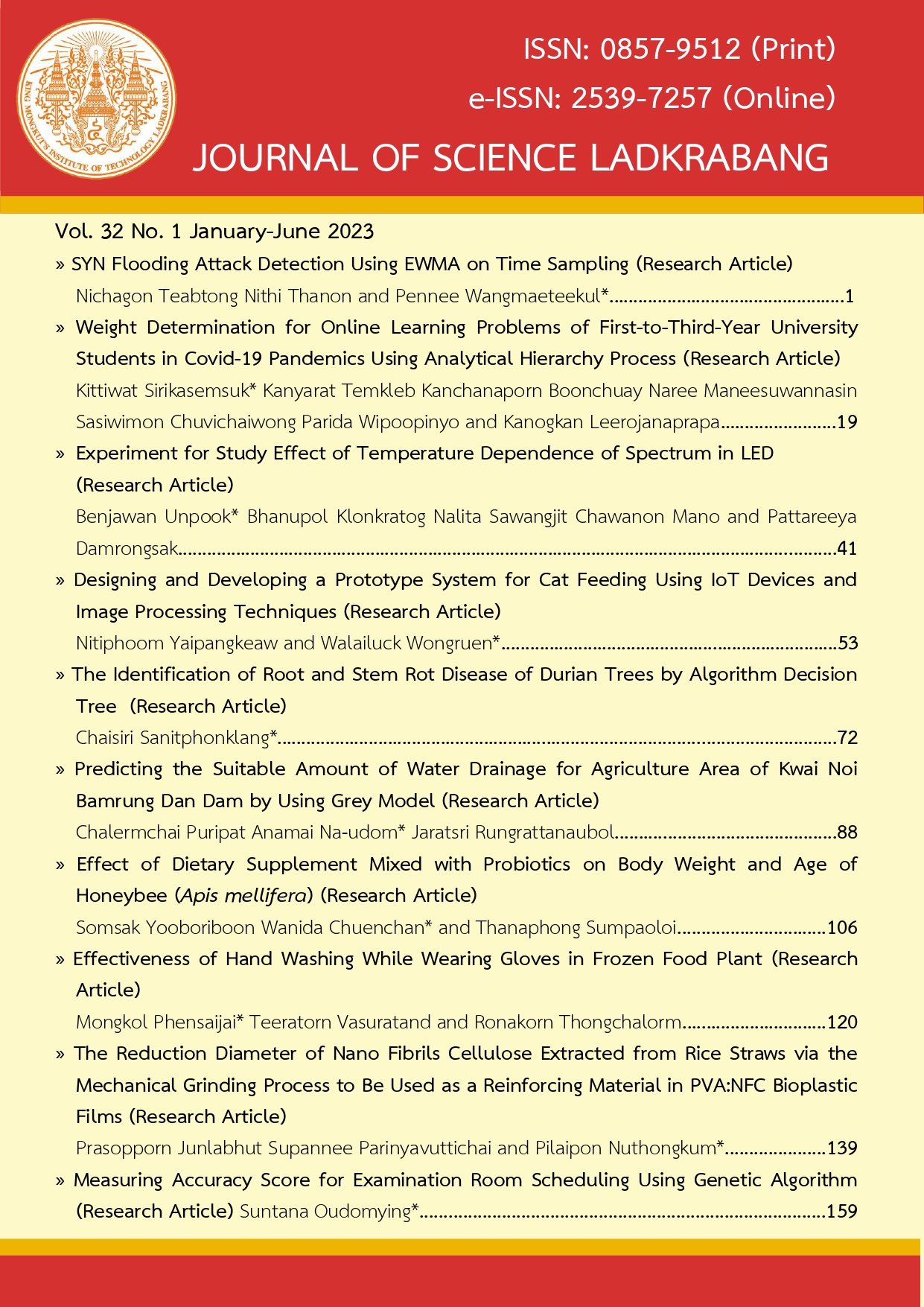The Identification of Root and Stem Rot Disease of Durian Trees by Algorithm Decision Tree
Main Article Content
Abstract
An essential problem in durian production is the outbreak of disease, especially root rot; stem rot of durian is the most critical disease. Due to this disease, mature and fruiting durian trees can die. The problems mentioned above must be urgently needed to find a way to help. This research aims to develop a model for the classification of root rot and stem rot disease of durian trees using a decision tree algorithm under the machine learning process. The data set originated from 50 agricultural people in Chumphon province, totaling 500 items. The datasets were divided into two groups: the first group, 150 items of root and stem rot disease of durian trees, referred to as class 1. The second group, the usual 350 items, referred to class 0. Before learning with decision tree algorithms, the data were balanced using Synthetic Minority Oversampling Technique (SMOTE). Decision Tree Algorithm (DT) used to classify the data was found to have an accuracy of 99.33 %, and accuracy comparisons were made with the Support Vector Machine (SVM), Random Forest (RF), and K-Nearest Neighbor algorithm (KNN) at 95.33 %, 93.66 %, and 91.33 %, respectively. Discovered that the characteristics of root rot disease durian tree root rot that is effective for classification have three characteristics, namely brown wood, fast gangrene, and there is a rancid smell in the rotten part.
Article Details

This work is licensed under a Creative Commons Attribution-NonCommercial-NoDerivatives 4.0 International License.
References
วันดี กฤษณพันธ์. 2541. สมุนไพรน่ารู้. พิมพ์ครั้งที่ 3, สำนักพิมพ์แห่งจุฬาลงกรณ์มหาวิทยาลัย, กรุงเทพมหานคร. [Wandee Gritsanapan. 1998. Interesting herbs to know. 3td ed, Chulalongkorn University Publisher, Bangkok. (in Thai)]
สำนักงานเศรษฐกิจการเกษตร. 2564. สารสนเทศเศรษฐกิจการเกษตรรายสินค้าปี 2564. สำนักงานเศรษฐกิจการเกษตรกระทรวงเกษตรและสหกรณ์ เอกสารสถิติการเกษตรเลขที่ 402 แหล่งข้อมูล : https://www.oae.go.th/assets/portals/1/files/jounal/2565/commodity2564.pdf. สืบค้นเมื่อวันที่ 20 มิถุนายน 2565.
อมรรัตน์ ภู่ไพบูลย์. 2557. โรครากเน่า โคนเน่า และโรคผลเน่าของทุเรียน. กรมวิชาการเกษตร, แหล่งข้อมูล : https://www.doa.go.th/share/. ค้นเมื่อวันที่ 25 มิถุนายน 2565.
Bawack, R. E., Wamba, S. F., & Carillo, K. D. A. 2021. A framework for understanding aritificial intelligence research: insights from practice. Journal of Enterprise Information Management, 34(2), 645-678.
นพรัตน์ นนท์ศิริ. 2022. การจำแนกข้อมูลเพื่อวินิจฉัยความเสี่ยงการเป็นโรคเบาหวานโดยใช้เทคนิควิธีแบบร่วมกันตัดสินใจและวิธีเลือกคุณลักษณะเด่นไปข้างหน้า. วารสารวิทยาศาสตร์และเทคโนโลยี มหาวิทยาลัยราชภัฏอุดรธานี, 10(2), 107-122. [Nonsiri N., Chaichitwanidchakol P. and Somkantha K. 2022. Data Classification for Diabetes Risk Diagnosis using Majority Voting Ensemble Method and Forward Feature Selection Method. Udon Thani Rajabhat University Journal of Sciences and Technology, 10(2), 107-122. (In Thai)]
ณัฐวดี หงษ์บุญมี และ ประภาศิริ ตรีพาณิชย์กุล. 2019. การเปรียบเทียบประสิทธิภาพการจำแนกข้อมูลเพื่อวิเคราะห์ปัจจัยความเสี่ยงที่ส่งผลต่อการ เกิดโรคไฮเปอร์ไทรอยด์ด้วยเทคนิคเหมืองข้อมูล. วารสารวิทยาการและเทคโนโลยีสารสนเทศ, 9(1), 41-51. [Hongboonmee, N., & Trepanichkul, P. 2019. Comparison of Data Classification Efficiency to Analyze Risk Factors that Affect the Occurrence of Hyperthyroid using Data Mining Techniques. Journal of Information Science and Technology, 9(1), 41-51. (In Thai)]
นฤมล ชูเมือง. 2021. การจำแนกสถานะทารกในครรภ์โดยการใช้เครื่องมือติดตามอัตราการเต้นของหัวใจและการหดรัดตัวของมดลูกด้วยเทคนิค ต้นไม้ตัดสินใจ. วารสารวิทยาศาสตร์เทคโนโลยีและนวัตกรรม, 2(4), 36-46. [Chumuang N. 2021. Fetal Status Classification with Heart Rate Tracker and CTG by using Decision Tree. Journal of Science Technology and Innovation (STIJ). 2(4), 36-46. (In Thai)]
อัจฉรา สุมังเกษตร และณัฐวุฒิ ศรีวิบูลย์. 2021. ระบบผู้เชี่ยวชาญการใช้สมุมไพรรักษาโรคบนฐานความรู้ภูมิปัญญาสุขภาพด้วยเทคนิคการจำแนกข้อมูลแบบต้นไม้ตัดสินใจ. วารสารศรีปทุมปริทัศน์, 13(1), 115-127. [Achara Sumungkaset and Nattavut Sriwiboon. 2021. The Expert System for Herbs Usage Based on Wisdom-Knowledge in Terms of Health Using Tree Classification Decision Techniques. Sripatum Review of Science and Technology, 13(1), 115-127. (In Thai)]
Somvanshi, M., Chavan, P., Tambade, S., & Shinde, S. V. 2016. A review of machine learning techniques using decision tree and support vector machine. In 2016 international conference on computing communication control and automation (ICCUBEA) , IEEE Pune Section, Pune, India. 1-7.
Fernández, A., Garcia, S., Herrera, F., & Chawla, N. V. 2018. SMOTE for learning from imbalanced data: progress and challenges, marking the 15-year anniversary. Journal of artificial intelligence research, 61, 863-905.
Chawla, N. V., Bowyer, K. W., Hall, L. O., & Kegelmeyer, W. P. 2002. SMOTE: synthetic minority over-sampling technique. Journal of artificial intelligence research, 16, 321-357.
Maldonado, S., Vairetti, C., Fernandez, A., & Herrera, F. 2022. FW-SMOTE: A feature-weighted oversampling approach for imbalanced classification. Pattern Recognition, 124, 108511.
Pyle, D. 1999. Data Preparation for Data Mining. Morgan Kaufmann Publishers, United States of America.
Brownlee, J (Jason Brownlee). 2022. Data Preparation for machine learning. Available at:http://14.99.188.242:8080/jspui/bitstream/123456789/14557/1/Data_Preparation_for_Machine_Learning_Data_Cleaning_C_Feature_Selection_C_and_Data_by_Jason_Brownlee.pdf.
Wang, H., Hsu, H., Diaz, M., & Calmon, F. P. 2021. To split or not to split: The impact of disparate treatment in classification. IEEE Transactions on Information Theory, 67(10), 6733-6757.
Rácz, A., Bajusz, D., & Héberger, K. 2021. Effect of dataset size and train/test split ratios in QSAR/QSPR multiclass classification. Molecules, 26(4), 1111.
Loh, W. Y., & Shih, Y. S. 1997. Split selection methods for classification trees. Statistica sinica, 7(4), 815 - 840.
. Lin, C. L., & Fan, C. L. 2019. Evaluation of CART, CHAID, and QUEST algorithms: a case study of construction defects in Taiwan. Journal of Asian Architecture and Building Engineering, 18(6), 539-553.
Kesornsit, W., Lorchirachoonkul, V., & Jitthavech, J. 2018. Imbalanced data problem solving in classification of diabetes patients. Khon Kaen University Research Journal, 18(3), 11-21.
Rokach, L., & Maimon, O. 2005. Top-down induction of decision trees classifiers-a survey. IEEE Transactions on Systems, Man, and Cybernetics, Part C (Applications and Reviews), 35(4), 476-487.
Stehman, Stephen V. 1997. Selecting and interpreting measures of thematic classification accuracy. Remote Sensing of Environment, 62 (1), 77–89.
ชัยศิริ สนิทพลกลาง และ สัตวัฏฏ์ คำศิริ. 2021. การจำแนกผู้สมัครที่ลังเลในการ ตัดสินใจศึกษาต่อเพื่อสร้างกลยุทธ์สนับสนุนการตัดสินใจให้เข้าศึกษาต่อ กรณี ศึกษามหาวิทยาลัยราชภัฏจันทรเกษม. วารสารวิทยาศาสตร์ลาดกระบัง, 30(2), 58-73. [Sanitphonklang, C., & Kumsiri, S. 2021. Identification of Applicants Who are Hesitant to Decide to Study in Order to Create Strategies to Support Decision-making for Admission Case Study of Chandrakasem Rajabhat University. Journal of Science Ladkrabang, 30(2), 58-73. (In Thai)]

